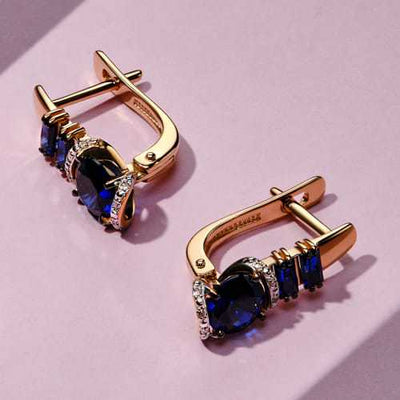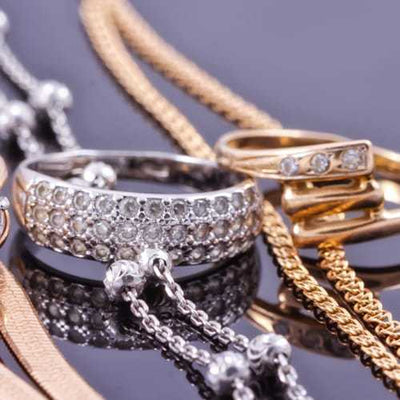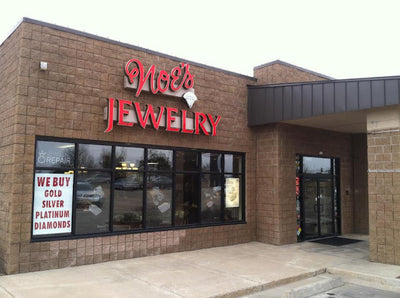Sapphires are gemstones that are part of the corundum family, which also includes rubies. When we think of sapphires, bright blue gemstones are brought into mind. However, fancy sapphires can come in a variety of colors. At Noe’s Jewelry, we know just how much our customers love blue sapphires and the other available color options, so we hope to educate buyers on these unique gemstones.
What is a Sapphire?
Sapphires belong to the mineral species corundum. There are two main varieties of sapphires: blue and fancy. Blue sapphires range in color from pure blue to greenish-blue and purplish-blue. The term sapphire can be applied to any variety of corundum that isn’t red and considered a ruby.
Corundum is composed of aluminum and oxygen. The growing environment for corundum needs to be free of silicon, which is a very common element. For this reason, natural corundum is fairly uncommon. The purest corundum is colorless. Colorless sapphires used to be used as diamond imitations. Sapphires get there coloring from trace elements.
Types of Sapphire
Like we previously mentioned, there are two main types of sapphires. The first is the blue sapphire. Blue sapphires, the September birthstone, are known for their vibrant coloring and unique appearance in the gem industry. The trace elements iron and titanium cause sapphires to have this blue appearance. The more iron the corundum contains, the darker the blue color the stone will exhibit.
Fancy sapphires can come in a variety of colors, including green, yellow, orange, pink, and purple. Fancy sapphires are often less available than blue sapphires. Additionally, some of the colors are very rare.
Parti-colored sapphires are also fairly common. These are sapphires that display a combination of colors. In some cases, these gems actually change color. Most often, sapphires will go from blue in the daylight or fluorescent lighting to purple under incandescent light.
There are even gray, black, and brown sapphires, although they aren’t highly desired for jewelry.
Where Are Sapphires Found?
 Sapphires have been found in a few parts of the world. Both blue and fancy sapphires have been found in Australia, Madagascar, Myanmar, Sri Lanka, and Tanzania. Fancy sapphires can also be found in East Africa.
Sapphires have been found in a few parts of the world. Both blue and fancy sapphires have been found in Australia, Madagascar, Myanmar, Sri Lanka, and Tanzania. Fancy sapphires can also be found in East Africa.
The Kashmir region of India and Pakistan is famous for the Kashmir-blue sapphire, but there are very few stones found in that area today.
4 C’s for Sapphires
Much like diamonds, sapphires are graded to determine their value on the market.Color
The most important factor when grading sapphires is the color. That is what you first notice when you see a sapphire. Grading the color of a sapphire requires a professional to look at and measure the hue, tone, and saturation of the color of the stone.
The hue of the stone describes the balance of color the stone has as it relates to its neighbors on the color wheel. For blue sapphires, you might say that the stone is blue, slight green, strong green, slight purple, or strong purple. The closer the sapphire is to true blue, the more desirable, and in turn, more expensive, the stone will be.
The tone of the color describes how dark or light the color is within said color’s range. The most prized stones will be in the medium to dark range. Lighter toned sapphires will look a bit watered down.
Saturation describes how vibrant the stone’s color is, and the range goes from dull to vivid. Pure vivid is the best saturation for gemstones because it makes the color look richer. In turn, the gemstone will be worth more.
Clarity
It would be unusual to find a sapphire without inclusions. In fact, a gemstone with no inclusions would automatically be suspected as a treated stone or a fake. This is due to the rutile needles, or silk, that all sapphires have. When looking at a sapphire with a naked eye, a professional will make sure that the stone in “eye-clean.” The cleaner the stone, the more the sapphire is worth.
There is an exception to this. Asterism, which is a form of inclusions, can increase the value of a sapphire. These inclusions are highly desirable because they add to the beauty of the gem.
Cut
There are no standardized cuts used for sapphires. Instead, gem cutters are expected to maximize the color, clarity, and brilliance of each individual stone. In most cases, sapphires are considered well-cut if they are symmetrical and reflect light at the correct angles. Some of the most common cuts for sapphires are oval, round, cushion, and emerald, as well as the unique cabochon cut.
When sapphires are cabochon cut, there is a unique phenomenon known as asterism or the star effect. Asterism shows up as a six-ray star pattern across the curved surface of the cabochon-cut stone’s surface. It occurs as white light reflects from numerous tiny, oriented needle-like inclusions within the sapphire.
Carat
Sapphires are denser than diamonds, so a one-carat sapphire will look smaller than a one-carat diamond. However, just like diamonds, the larger the carat weight, the more valuable the gemstone.Caring for Sapphires
In general, sapphires require very little maintenance, and they hold up to regular wear very well. However, dirt and other gunk can make your sapphire look dirty and dull. Fortunately, cleaning these gems is pretty easy.
Using warm water and a small amount of mild detergent, you can gently scrub the stone with a soft-bristled toothbrush. When you are finished, you should rinse the stone thoroughly with warm water and dry it with a soft cloth. If the stone is especially dirty, you can soak the stone in lukewarm water for 10 to 15 minutes. You can also have the stone professionally cleaned once a year, which also allows a professional to make sure that the stone is still in good condition.
If you are looking for beautiful sapphire jewelry, look no further than Noe’s Jewelry in Raymore, Missouri. If you have any questions, call us today at 816-322-7227.
Check out the other stones in our Gemstone Series Guides:





